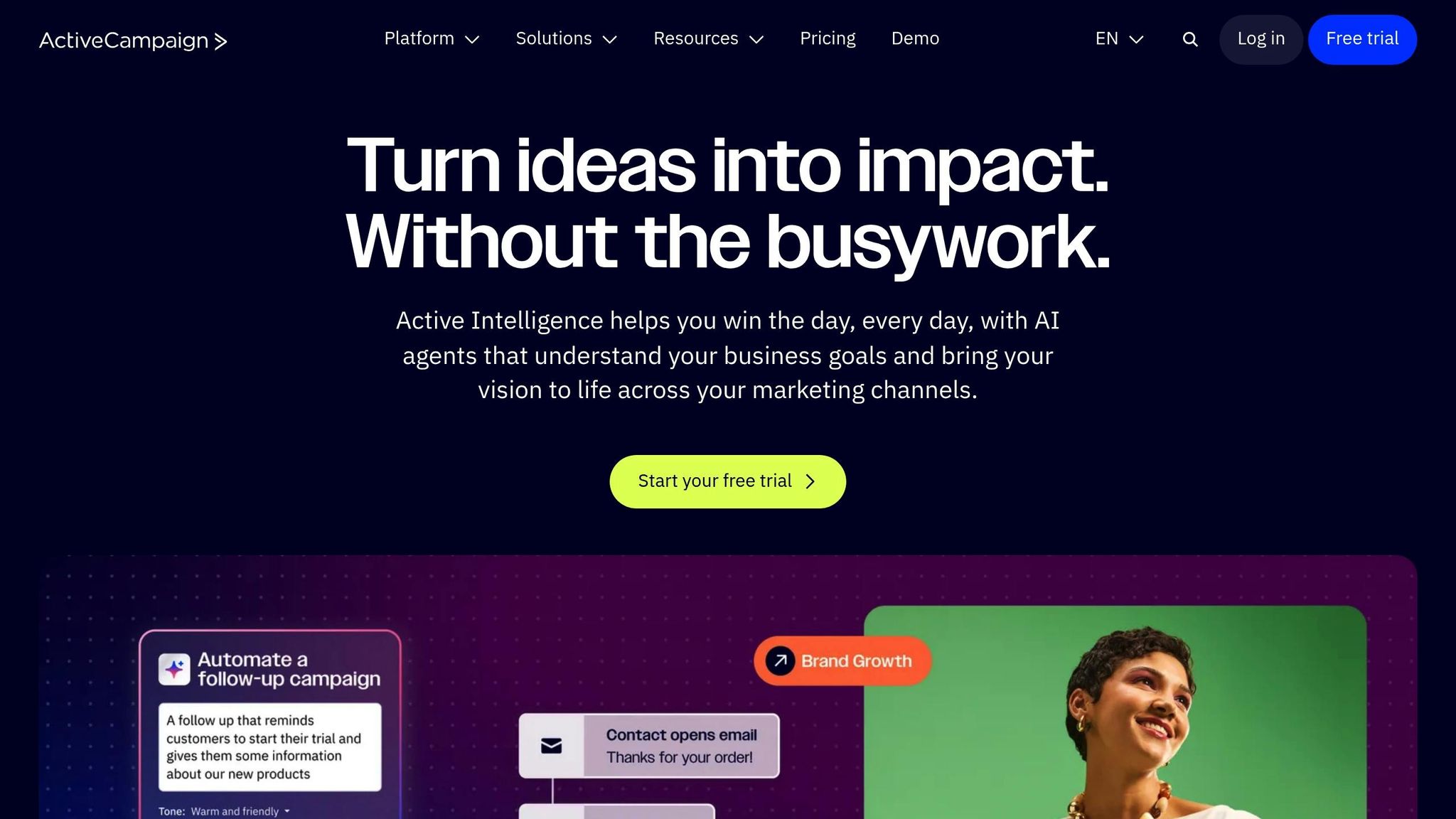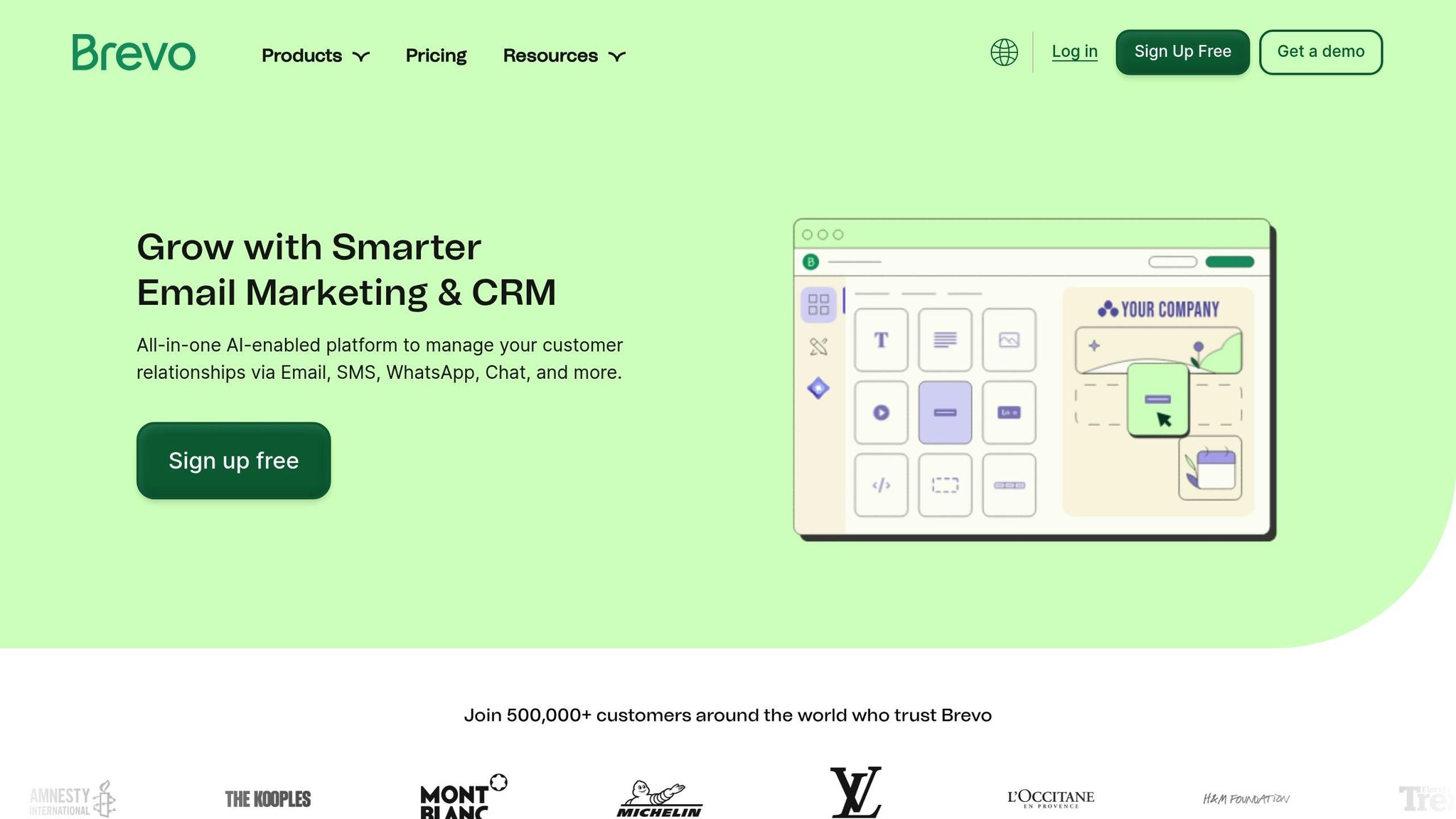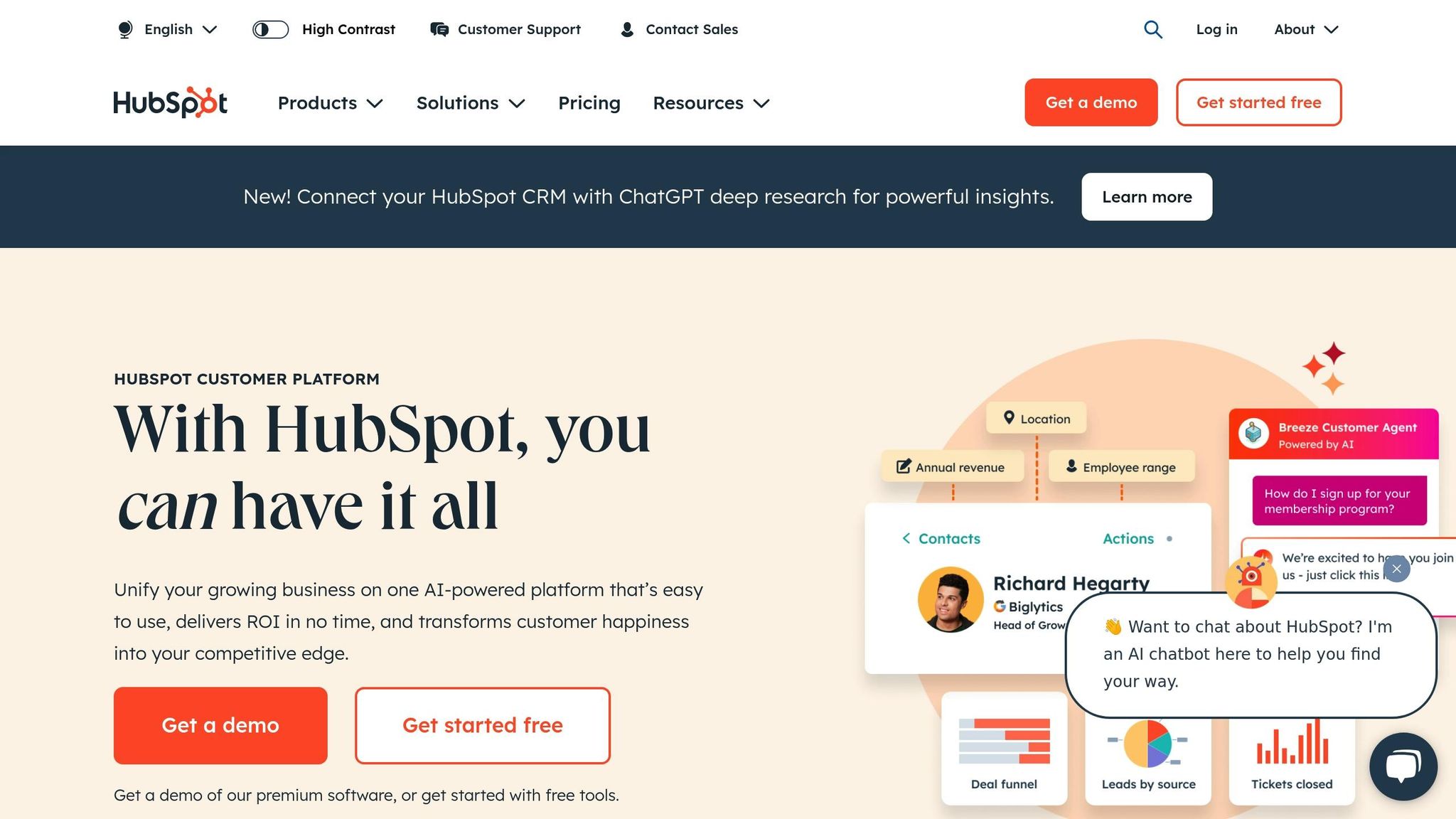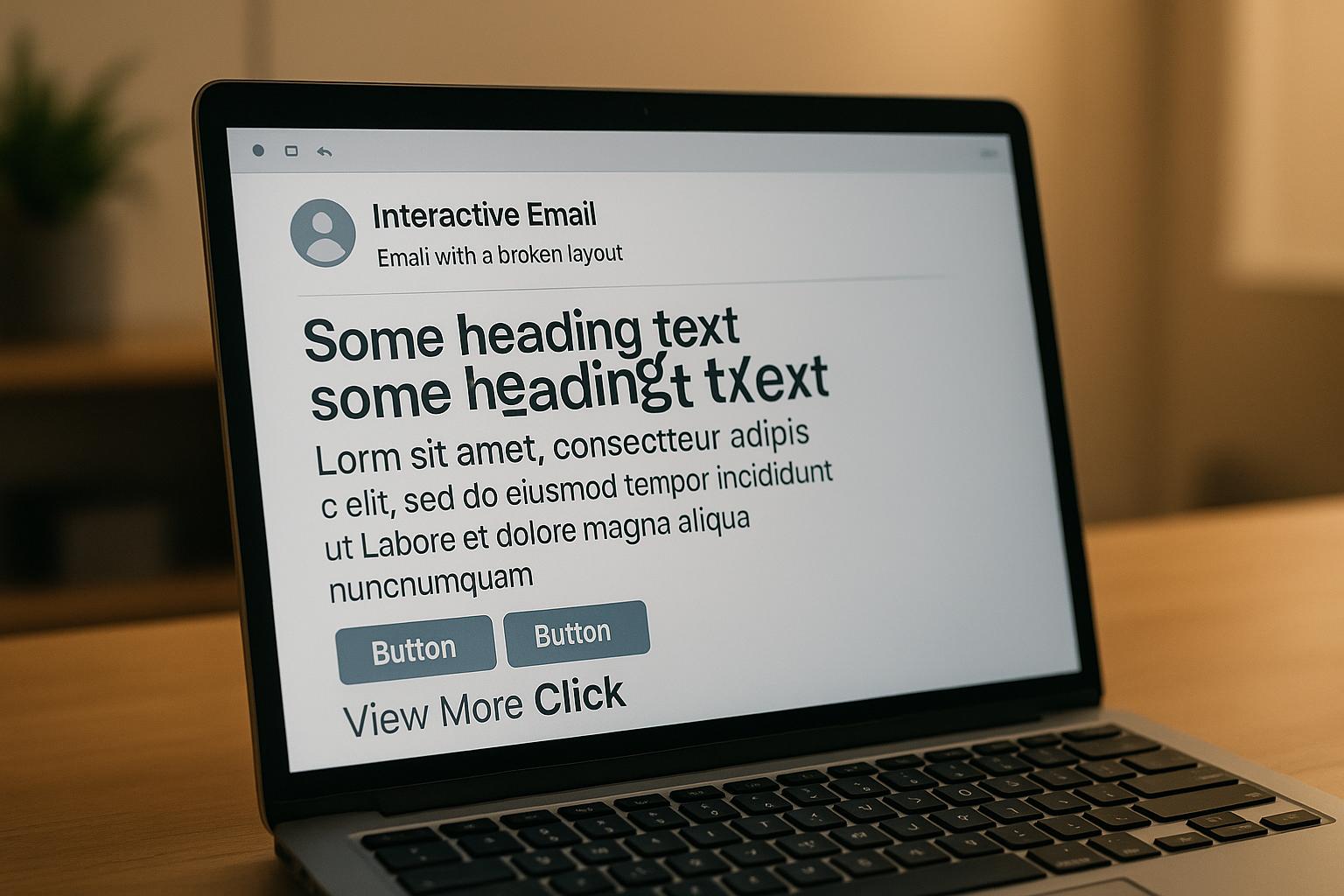A/B testing is a must for improving B2B email campaigns. It helps you make data-driven decisions to boost open rates, click-through rates, and conversions. Here’s a quick guide to the best tools for A/B testing in 2025:
- ActiveCampaign: Best for advanced automation and multivariate testing. Starts at $19/month.
- Brevo: Perfect for beginners with a simple interface and affordable plans starting at $25/month.
- Mailchimp: Ideal for small teams with beginner-friendly features. Starts at $29/month.
- GetResponse: Best for detailed analytics and AI-driven insights. Pricing starts at $19/month.
- HubSpot: Great for enterprise teams needing CRM integration. A/B testing available in plans starting at $1,300/month.
Quick Comparison Table
| Tool | Starting Price | Best For | Key Features |
|---|---|---|---|
| ActiveCampaign | $19/month | Advanced automation | Multivariate testing, behavioral triggers |
| Brevo | $25/month | Beginners | Easy setup, generous free plan |
| Mailchimp | $29/month | Small teams | Simple interface, strong segmentation |
| GetResponse | $19/month | Data-driven insights | AI-powered analytics, sample size calculator |
| HubSpot | $1,300/month | Enterprise integration | CRM integration, advanced testing |
Pro Tip: Start with free trials or demos to find the right tool for your needs. Focus on testing high-impact elements like subject lines and CTAs to quickly optimize your campaigns.
A/B testing and optimization for B2B emails
How to Choose the Best A/B Testing Tools
To get the most out of your B2B email campaigns, picking the right A/B testing tool is critical. With 44% of companies not conducting any split testing, using the right platform can give you a serious advantage. The goal is to find a tool that aligns with your team's needs, budget, and technical setup while delivering reliable insights. Here's what to look for.
Key Features for Effective Testing
A good A/B testing tool should provide accurate statistical analysis and reporting. It needs to calculate statistical significance using proven methods, such as Frequentist or Bayesian approaches. Without this, your results may not hold up, leading to unreliable decisions.
For B2B campaigns, segmentation and targeting capabilities are a must. Unlike B2C audiences, B2B campaigns often involve multiple decision-makers - on average, 6 to 10 stakeholders per purchase. Your tool should be able to handle these complexities, especially since personalized subject lines are 26% more likely to be opened than generic ones.
The ability to perform both simple A/B testing and multivariate testing is another essential feature. While A/B testing is great for tweaking one or two elements, like subject lines or call-to-action buttons, multivariate testing allows you to experiment with multiple variables at once - think layout, images, and messaging. This provides deeper insights into what combinations work best.
Integration is non-negotiable. Your A/B testing tool should connect seamlessly with your CRM, analytics, and automation platforms to ensure smooth data flow. Manual data transfers not only waste time but can also introduce errors that skew your results.
Finally, reliability matters. Opt for tools with 99.9% uptime or better to ensure your tests run without interruptions. A tool that slows down or crashes during testing can distort results and waste valuable time.
Integration with Existing Marketing Platforms
Efficient data tracking depends on smooth integration with your existing tools. When your A/B testing platform connects seamlessly with your CRM and automation software, you can track the entire customer journey - from the moment they open your email to the final conversion.
For example, Spotify used Mailchimp's Email Verification API in March 2023 to clean its 45-million-subscriber database. This integration enabled real-time email verification, cutting their bounce rate from 12.3% to 2.1% in just 60 days. The result? An additional $2.3 million in revenue.
Once you've confirmed the technical fit, it's time to think about cost.
Budget Considerations for B2B Teams
When budgeting for A/B testing tools, balance cost with functionality. Keep in mind that A/B testing can boost conversion rates by up to 49%, making it a worthwhile investment when implemented correctly.
Pricing varies widely depending on the features and scale of the tool. For instance:
- Zoho PageSense starts at $12/month (billed annually).
- Convert begins at $349/month (billed annually).
- Unbounce offers plans starting at $112/month (billed annually).
Enterprise-level solutions cost more but often include unlimited contacts and priority support.
If you're debating whether to manage testing in-house or hire an agency, consider this: agency fees range from $2,000 to $25,000 per month. Agencies typically achieve 21% more successful tests than in-house teams, according to a study of 28,000 Convert users. However, in-house teams can achieve similar results as they gain expertise.
"At the end of the day, an A/B testing tool is only as good as the people using it. It will always assign users at random according to your set parameters. And even though it calls winners for you, it is best to have a strong grasp of the fundamentals of statistics to run successful A/B tests." - Trina Moitra, Convert.com
Define your primary goals - whether it's improving open rates, click-through rates, or revenue per email - so you can choose a tool that delivers the right analytics. Focus on testing high-impact elements to quickly show results and prove ROI to stakeholders.
Building a repository of past tests can also streamline future efforts and foster a testing culture within your organization. Over time, this approach reduces costs per test and demonstrates consistent performance improvements, making the investment in an A/B testing tool well worth it.
Top Tools for A/B Testing B2B Email Campaigns in 2025
Here’s a breakdown of some top-notch tools for A/B testing B2B email campaigns in 2025. Each tool brings something different to the table, whether it’s automation, simplicity, or data-driven insights.
ActiveCampaign: Best for Advanced Automation

ActiveCampaign is a powerhouse when it comes to automation and multivariate testing. It allows you to test everything from subject lines to send times and content variations. One standout feature is its behavioral trigger testing, which adapts automated email sequences based on user actions. For instance, if someone opens an email but doesn’t click, the system can automatically send a tailored follow-up.
It integrates smoothly with platforms like Salesforce, HubSpot, Shopify, WordPress, Unbounce, Calendly, Typeform, and Facebook Ads. Pricing starts at $19/month for 1,000 contacts, with advanced features available from $59/month (annual plans include a 20% discount). With a 4.5/5 rating on G2, users often highlight its intuitive design, making it accessible for both beginners and experienced marketers.
Pros:
- Sophisticated automation workflows
- Multivariate testing options
- Extensive integrations
- Responsive behavioral triggers
Cons:
- Steeper learning curve
- Costs increase as your contact list grows
Brevo: Best for Simplicity and Beginners

Brevo (formerly Sendinblue) is a great choice for those new to email marketing. The platform offers an easy setup process and a clean, user-friendly reporting dashboard.
Brevo’s free plan is generous, allowing you to send up to 9,000 emails per month and manage as many as 100,000 contacts. It works seamlessly within the Zoho ecosystem and integrates with other popular tools. Users frequently praise its customer support:
"Really efficient support. They answer pretty quickly to every situation and try to find the best possible solution to every problem." – Driss Hafid, Brevo user
With a 4.5/5 rating on G2 and 4.3/5 on Trustpilot, Brevo is also budget-friendly, starting at $25/month for 5,000 contacts and $49/month for 50,000 contacts.
Pros:
- Easy-to-use interface
- Generous free plan
- Excellent customer support
- Affordable pricing
Cons:
- A/B testing limited to higher-tier plans
- Fewer advanced automation features
Mailchimp: Best for Small B2B Teams

Mailchimp is a go-to for small B2B teams, thanks to its simple interface and straightforward A/B testing features. It’s particularly well-suited for beginners who need an intuitive platform to set up and analyze tests.
The visual email builder makes creating variations simple, while its analytics dashboard clearly highlights which version performs better. Mailchimp’s segmentation tools are also useful for targeting different decision-makers within a business.
Pricing starts at $29/month for 1,000 contacts, with A/B testing included in the basic plan. The free plan allows for 1,000 emails per month for up to 500 contacts but includes Mailchimp branding. While it holds a 4.4/5 G2 rating, Trustpilot reviews are less favorable at 1.3/5.
Pros:
- Beginner-friendly interface
- Strong brand recognition
- Effective segmentation tools
- Visual email builder
Cons:
- Costs rise quickly with larger lists
- Mixed customer service reviews
- Limited advanced automation features
GetResponse: Best for Data-Driven Insights

GetResponse shines when it comes to analytics and reporting. Its sample size selector ensures you have enough data for meaningful results, and its AI-powered insights recommend optimal send times and content adjustments based on audience behavior. These features make it a strong option for B2B campaigns that need to be data-focused.
Pricing starts at $19/month for 1,000 contacts, scaling to $54/month for 5,000 contacts and $299/month for 50,000 contacts. It holds a 4.2/5 G2 rating and a 3.9/5 Trustpilot rating.
Pros:
- Detailed analytics tools
- AI-driven insights for optimization
- Sample size calculator
- Automation features
Cons:
- Interface can feel cluttered
- Steeper learning curve for advanced tools
HubSpot: Best for Enterprise Integration

HubSpot is ideal for businesses that need to integrate A/B testing with a CRM and sales platform. Its all-in-one approach combines email, CRM, and sales tools, making it perfect for larger operations that require unified data across teams.
HubSpot’s advanced features include progressive profiling and landing page optimization, allowing you to test entire customer journeys rather than just individual emails. This makes it particularly effective for complex B2B sales cycles with multiple touchpoints.
That level of sophistication comes at a price. The Marketing Hub starts at $20/month, but A/B testing is only available in the Professional plan, which costs $1,300/month for 2,000 contacts. Enterprise plans start at $4,300/month. HubSpot has a 4.4/5 rating on G2, but Trustpilot reviews are lower at 2.6/5.
Pros:
- Full CRM and sales platform integration
- Advanced testing capabilities
- Unified reporting for marketing and sales
- Ideal for complex sales cycles
Cons:
- High costs for smaller teams
- Complex setup process
- Many features locked behind premium plans
Explore these tools to find the one that aligns best with your B2B email marketing goals. Each offers unique strengths, so the right choice depends on your team’s size, budget, and specific needs.
sbb-itb-6e7333f
Comparison of Top A/B Testing Tools
This section highlights the key differences and strengths of popular A/B testing tools, helping you make an informed decision based on your needs.
Testing Capabilities and Flexibility
When it comes to testing capabilities, ActiveCampaign and GetResponse stand out, allowing up to five email variations. This flexibility lets you test multiple elements using custom segmentation. Mailchimp, while limited to three variations per test, compensates with AI-driven optimization to refine results. Brevo focuses on testing subject lines and email content, offering AI-powered send-time optimization, making it a great option for teams new to A/B testing. Meanwhile, HubSpot takes a broader approach, enabling tests across entire email sequences, landing pages, and workflows to evaluate the full customer journey.
Pricing Comparison
Pricing plays a critical role when selecting the right tool. Here's a quick comparison of starting prices and A/B testing availability:
| Tool | Starting Price | A/B Testing Availability |
|---|---|---|
| GetResponse | ~$14/month | Included in the Basic plan |
| Mailchimp | $6.50/month | Available on the Basic plan (3 variations) |
| Brevo | $25/month | Available starting from the Business plan ($65/month) |
| ActiveCampaign | $29/month | Included in the Basic plan (up to 5 variations) |
| HubSpot | $18/month (Marketing Hub) | Available in the Professional plan ($800/month) |
These pricing tiers highlight the range of options available, ensuring there's a solution for every budget and campaign scale.
Integration Ecosystem Strength
ActiveCampaign leads the pack with over 920 integrations, including popular platforms like Microsoft, WordPress, Facebook, and Shopify, making it a versatile choice for businesses with diverse tool stacks. HubSpot focuses on deep CRM integration, which is especially valuable for account-based marketing strategies. Mailchimp, while not as extensive, offers a strong selection of integrations that work well for enterprise campaigns.
Analytics and Reporting Depth
Analytics is a cornerstone of effective A/B testing, and different tools excel in this area:
- GetResponse provides detailed analytics, including a sample size calculator to ensure statistical accuracy. Its AI-powered insights help optimize send times and fine-tune content based on audience behavior.
- ActiveCampaign offers customizable metrics and AI-driven analytics to track performance across campaigns.
- HubSpot integrates A/B testing results with CRM and sales data, offering a clear view of campaign ROI and long-term impact.
Best Fit Scenarios
Each tool shines in specific scenarios, depending on team size, budget, and goals:
- Small B2B Teams: For teams managing fewer than 5,000 contacts, GetResponse and Mailchimp provide easy-to-use A/B testing features at entry-level prices.
- Medium-Sized Teams: Businesses with 5,000–50,000 contacts may find ActiveCampaign’s automation capabilities or GetResponse’s analytics tools particularly useful.
- Enterprise Operations: For large-scale operations requiring deep CRM integration and comprehensive testing, HubSpot is a premium but highly effective option.
- Simplicity Seekers: If your team values a straightforward approach, Brevo offers a focused and easy-to-navigate solution for A/B testing.
Choosing the right tool comes down to evaluating your team’s size, budget, and specific testing needs. Each platform has its own advantages, so aligning these with your campaign goals will help you make the most of your investment.
How to Choose the Right Tool for Your Business
Finding the perfect A/B testing tool for your business requires a thoughtful approach that aligns with your team's goals, technical needs, and budget. Rushing this decision can lead to wasted resources and missed opportunities to improve your campaigns. Taking the time to choose wisely ensures your A/B testing efforts deliver the meaningful results you're aiming for.
Define Your Testing Goals
Before diving into tool comparisons, it's essential to get clear on your A/B testing objectives. Rob Gaer, Senior Software Engineer at Miro, highlights the benefits of email marketing A/B testing: “solving user problems and improving UX, driving growth and business impact, optimizing content for diverse audience segments as well as gaining insight and learnings you can apply to future campaigns”.
Start by pinpointing the email elements you plan to test most often. For example:
- If open rates are your main concern, look for tools like Brevo that specialize in subject line testing.
- For testing multiple email variations and optimizing content, platforms such as ActiveCampaign or GetResponse might be a better fit.
Consider the challenges you're facing, whether it's low click-through rates or high unsubscribe rates. This will help you prioritize tools with features designed to tackle those specific problems. If your campaigns require advanced audience segmentation - like targeting based on company size, industry, or buying stage - make sure to focus on tools with robust segmentation options.
Evaluate Tool Features and Usability
Once your goals are clear, evaluate how well different tools align with your operational needs. The right tool strikes a balance between functionality and ease of use, making it easier for your team to adopt and integrate into workflows. Look for a clean interface and core features that directly support your testing objectives. While advanced customization options can be a bonus, they may require additional technical expertise.
As your testing strategy evolves, you may want tools with advanced features such as send-time optimization, graphical element testing, and enhanced segmentation capabilities.
Integration options are another critical factor. Check whether the tool works seamlessly with your existing CRM or marketing automation systems. Most platforms list their integration partners on their websites, so you can verify compatibility upfront.
Don't underestimate the importance of user experience. For example, ActiveCampaign offers a good mix of advanced features and user-friendly design, while Brevo is ideal for teams just starting with A/B testing and looking for simplicity. Also, consider the quality of customer support. Responsive technical support, detailed documentation, and effective onboarding resources can make a big difference in how smoothly your team adopts the tool.
Use Free Trials and Demos
After narrowing down your options, it's time to test them in real-world scenarios. Most A/B testing tools offer free trials or starter plans, giving you a chance to see how they perform with your actual campaigns.
Set up a basic A/B test using your typical email format and audience segments. This will help you identify any usability issues or limitations that might not be obvious during a product demo. Pay close attention to the user interface - is it intuitive enough for your team to navigate between test setup, monitoring, and results analysis? Are the analytics reports clear and actionable?
Schedule demos with vendors and come prepared with specific questions about integration, data migration, and scalability as your email list grows. If you're switching from an existing tool, consider running parallel tests to ensure the new platform delivers consistent results and meets your expectations before fully transitioning.
"Before choosing any A/B testing software, ask yourself, 'What kind of tests do I want to run? What features do I need? What is my budget?'"
Don't forget to explore resources like the Email Service Business Directory, which offers curated comparisons of email marketing platforms. These resources can help you identify the best tools for your specific A/B testing needs.
Conclusion: Optimizing B2B Email Campaigns with A/B Testing
A/B testing transforms B2B email marketing into a measurable and data-focused strategy. For example, River Island's approach to testing email frequency led to impressive results: a 30.9% boost in revenue and a 30.7% increase in orders, all while cutting their total send volume by 22.5%. These gains don’t just improve individual campaigns - they can influence your broader marketing strategy.
By relying on real data, A/B testing enables smarter decisions and better conversion rates without increasing costs. Considering email marketing offers an average return of $36 for every dollar spent, fine-tuning your campaigns through testing becomes a powerful way to stay ahead in the competitive B2B space.
Key Takeaways
The tools discussed earlier in this guide each bring unique strengths to A/B testing. For instance:
- ActiveCampaign allows for testing up to five variations, ideal for complex automation workflows.
- Brevo offers a straightforward platform, perfect for beginners looking to get started quickly.
- Mailchimp excels in segmentation, helping you target multiple decision-makers in B2B environments.
- GetResponse includes features for precise statistical analysis, ensuring reliable results.
- HubSpot integrates testing with CRM data, offering a unified view of customer behavior.
Since nearly half of recipients (47%) decide to open emails based on the subject line alone, focus your tests on one variable at a time. This ensures you can clearly measure its impact. Start by testing your most frequently sent emails and prioritize elements tied directly to your key performance indicators (KPIs).
Additional Resources
For further support, the Email Service Business Directory is a helpful tool for comparing platforms and service providers. This directory simplifies the process of finding solutions tailored to your A/B testing needs and budget.
Take advantage of free trials and demos to explore these tools before committing. Choosing the right A/B testing platform can lead to better engagement, increased conversions, and a stronger ROI for your B2B email marketing campaigns.
FAQs
What should I look for in an A/B testing tool for B2B email campaigns?
When selecting an A/B testing tool for your B2B email campaigns, it's important to zero in on a few essential factors to ensure it aligns with your goals. Look for features that allow you to test subject lines, email content, CTAs, and even send times. Tools that offer audience segmentation and real-time performance tracking can give you a better understanding of what works best for your audience.
The tool's ease of use matters too - it should make setting up tests and analyzing results straightforward, leaving you more time to focus on crafting an effective strategy. Don't overlook the importance of analytics. A tool with clear, detailed insights into metrics like open rates and conversions can be a game-changer for refining your campaigns.
Additionally, make sure the tool integrates smoothly with your current email marketing platform and CRM. This ensures seamless data sharing and a more efficient workflow. Finally, consider the cost - the tool should fit within your budget while still offering the features you need to boost engagement and drive results. A well-chosen tool can make a noticeable difference in the success of your campaigns.
How does connecting A/B testing tools with your CRM boost the success of B2B email campaigns?
Integrating A/B testing tools with your CRM can take your B2B email campaigns to the next level by allowing for more precise audience targeting. With the detailed customer data stored in your CRM - like behaviors, preferences, and demographics - you can design highly specific tests. This means your email content, subject lines, and calls-to-action (CTAs) are tailored to resonate with the right audience.
Even better, the insights gained from these A/B tests can be fed back into your CRM. This creates a feedback loop that sharpens your future campaigns, aligning them more closely with what your customers actually want. The result? Better engagement, improved conversion rates, and a stronger return on investment (ROI) for your email marketing efforts. Pairing A/B testing with your CRM allows you to make smarter, data-driven decisions that amplify your campaign's effectiveness.
What makes multivariate testing more effective than basic A/B testing in B2B email marketing?
Multivariate testing takes things a step further than basic A/B testing by allowing you to test multiple elements - like subject lines, images, and call-to-action buttons - all at once. This approach helps pinpoint the combinations that resonate best with your audience, giving you a clearer picture of what drives engagement and boosts conversions in your email campaigns.
One major advantage? It saves time. Instead of running separate A/B tests for each variable, multivariate testing evaluates all possible combinations simultaneously. This speeds up the optimization process, letting you make adjustments and roll out effective strategies faster - an essential edge in the fast-moving B2B world.


